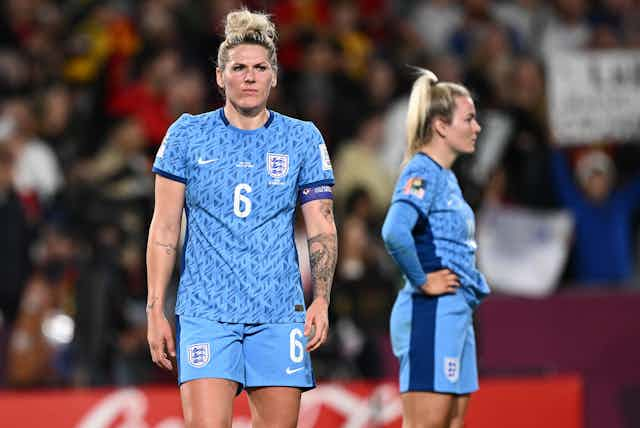Despite the disappointment of losing to Spain in the final, England’s women’s football team had a very good World Cup, on and off the pitch. Viewing figures were huge, media coverage was unprecedented and excitement about potential future achievements seems high.
So women’s football in England looks to be strong and in safe hands. And at first glance its domestic top tier, the Women’s Super League (WSL), certainly looks healthy.
League match attendance records have been broken recently, as they have for the women’s FA Cup, and Champions League tournaments. The increase in coverage has continued at pace, with a ground breaking broadcast deal with the BBC and Sky worth £8 million a season.
Across the league, club revenue increased by 590% from 2011 to 2019. And those clubs were extremely well represented by key players at the World Cup, including the likes of England’s Mary Earps (Manchester United), Australia’s Sam Kerr (Chelsea) and Sweden’s Stina Blackstenius (Arsenal).
But without wishing to rain on the Lionesses’ parade, our latest research indicates some worrying times ahead – and some critical concerns about the WSL’s financial sustainability.
For while income in the league has dramatically increased, we found that so too has debt for clubs – which has skyrocketed by an average of 1,351%. This is an alarming level which could ultimately jeopardise the entire league’s financial stability and the survival of some major clubs.
This debt is mostly connected to loans to the women’s sides from the men’s clubs they are linked to, rather than a reflection of increased interest rates or expensive infrastructure projects.
Our research also found other signs that the financial sustainability of the WSL has been in decline. Club profits have fallen from a small average of £4,000 in 2010 to average losses of £1.4 million in 2019.
This is a worrying trend which indicates that the women’s leagues could be heading in the same direction as the men’s, with greater financial risks and increased chances of clubs going into administration or disappearing altogether.
Financial pressure
Our research also found a noticeable split emerging within the WSL, with the most successful teams’ finances apparently not linked to success or failure on the pitch. Instead, these teams are better at using their strong brand identity to secure corporate sponsorship and a loyal ticket buying fan base.
For the sides lower down the league, however, the state of their finances was linked with league position, so that their income very much depends on how well they play. Poorer form appears to be matched by less corporate sponsorship, fewer flagship events in men’s stadiums and fewer season ticket sales. They end up being much more reliant on the traditional business model of football, which depends on match day attendance and sponsors.

WSL clubs’ wage bills are also under more pressure – even though the women players earn a fraction of their male colleagues (very little information is available about exact sums). This follows the traditional football club business model, in that a large proportion of income ends up going on wages – often considered a good thing for athletes and club performance. But when wage bills become unaffordable, clubs can go under.
There is hope though. Since we began our recent our analysis, the first of its kind in women’s professional sport, England’s female footballers have continued to inspire new interest and investment. We discovered areas of serious concern – but also strengths in the women’s game which can be built on.
After the independent review led by journalist Karen Carney paved the way for much needed change, our research tells us the situation is more precarious than the WSL may have realised. It is now vital that the league heeds Carney’s recommendations, learns from others’ mistakes and ultimately chooses a sustainable path with room to grow.
Women’s football in England has enormous potential – but the players, the fans and the people who govern the game should know that a much stronger economic basis throughout the league has become an urgent requirement.

